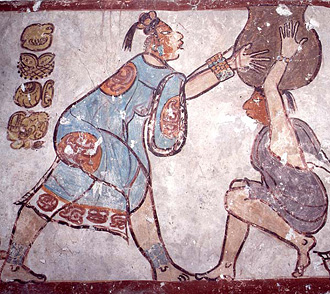Murals Discovered at Mayan Excavation in Mexico
 Margaret Shapiro - Washington Post Margaret Shapiro - Washington Post
go to original
December 15, 2009

| 
Click image to enlarge | | Pintura mural. Cultura maya. Clásico Temprano. Edificio 1, Acrópolis Norte. Calakmul, Campeche. (Jorge Pérez de Lara/Raíces) |  |
Newly discovered Mayan murals, uncovered during an excavation at Calakmul in southeast Mexico, offer a glimpse of the life of ordinary people instead of the more common depictions of the concerns and lives of Mayan ruling elites, according to the researchers who found the works.

The wall murals, which probably date from the 7th century, were preserved by a layer of clay when new buildings were constructed over the original one.

They show groups of men, women and children doing such things as preparing food and tobacco, drinking maize gruel, serving and eating maize-bread tamales, wearing tall decorated hats and carrying large, rope-tied bundles.

Hieroglyphic captions, including some using symbols that researchers hadn't encountered before, accompany some of the murals.

The report of the findings, published recently in the journal Proceedings of the National Academy of Sciences, noted that about one-third of the drawings are of women, including what may be the only depiction known of an "nonmythological" elderly Mayan woman.

"The murals are notable examples of Maya art, but their scientific value lies primarily in the information conveyed in their imagery," the researchers wrote.

Earlier murals discovered elsewhere illuminate "warfare and royal rituals" or "religious thought and writing" of the very hierarchical Maya society, they said.

But the new ones offer "insights into quotidian activities."

Simon Martin, an associate curator of the University of Pennsylvania Museum and an author of the report, said the "most significant finds are the ones that have hieroglyphic captions naming hitherto unseen spellings of food stuffs. Even though maize was a staple of the Maya diet, we have never seen the word for maize-grain, 'ixi'm,' in a text before.

"The same is true for 'atz'aam,' salt; even though salt production was a massive industry on the coast, it never otherwise appears in the inscriptions."

Calakmul, Martin said, "is still buried, quite literally, in the rain forest."

The site is in state of Campeche, near Guatemala.

"When we've gathered more evidence and can really see the context of the murals, I think they will change the way we think about daily life in a major Maya capital," Martin said. |



